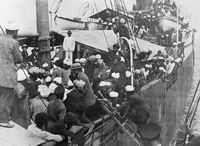|
|
Seeds of Fire: A People’s Chronology
Recalling events that happened on this day in history.
Memories of struggle, resistance and persistence.
Compiled by Ulli Diemer
|
May 23, 1838
|
|
|
U.S. General Winfield Scott begins the forced removal of the Cherokee nation from their lands in North Carolina, Georgia, Alabama, and Tennessee. As a first step, they are imprisoned in detention forts built to hold them; then the military starts them on their forced march west to Oklahoma. An estimated 4,000 Cherokee die en route.
This is one of a long series of forced “Indian Removals” in the United States.
|
|
May 23, 1914
|

|
|
The Komagata Maru sails into Burrard Inlet, near Vancouver. On board the ship are 376 Indian citizens: 340 Sikhs, 24 Muslims, and 12 Hindus. They are all British subjects, and have made the journey in a deliberate challenge to Canada’s exclusionist laws and policies, which make entry to Canada easy for white British subjects, but seek to exclude non-whites.
Canadian and B.C. authorities refuse to let the passengers leave the ship, saying that it has not sailed non-stop from India (a rule deliberately designed to block arrivals from India) and that the passengers did not have the $200 each required to enter British Columbia (the equivalent of about seven years’ pay for the average Indian).
The government refuses to allow food and water to be brought aboard the ship, but local supporters manage to smuggle supplies to the ship to keep the passengers alive.
On shore, local politicians organize an anti-Asian rally. Attempts are made to board the ship, but are fought off by the passengers.
Finally, on July 21, the newly formed Royal Canadian Navy, in its very first official action, is called in to force the Komagata Maru to leave at gunpoint. Twenty passengers who already had resident status in Canada are allowed to disembark; the rest are forced to return.
The ship arrives in Calcutta on September 26. There, the passengers are detained by the British imperial authorities. In an ensuing confrontation, 20 passengers are killed and nine are wounded.
|
|
May 23 - 24, 1934
|
|
|
The start of the “Battle of Toledo,” a five-day running battle pitching striking workers in Toledo against police, national guard troops, and hired thugs.
Workers at the Electric Auto-Lite company went on strike April 12 demanding recognition of their union, a wage increase, improved working conditions, and an end to harassment of, and discrimination against, union members.
The strike draws support from the socialist American Workers Party (AWP), which sends organizers to help. The AWP sets out to organize unemployed workers in support of the strike; they succeed in bringing out thousands of jobless workers to help surround the plant and shut it down.
The company appeals to the capitalist courts to prevent picketing, and are quickly granted an injunction forbidding more than a handful of pickets outside the gates. Despite continuing arrests, the workers defy the injunction: by May 23, there are more than 10,000 pickets outside the plant gates.
Police attack, and a full-fledged battle breaks out that continues over the next five days. Two strikers are killed, and more than 200 are injured.
The strike ends when the company, prodded by a federal mediator, agrees to recognize the union, grant a wage increase, and rehire all workers who had been fired for their actions during the strike. On June 9th, a massive victory parade in Toledo marks the end of the strike, which is regarded as one of the most important strikes in U.S. labour history.
|
|
For more information about people and events in Seeds of Fire, explore these pages:
|
|
|
|
|
|

